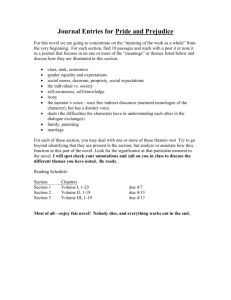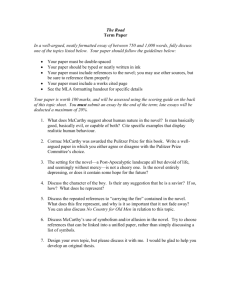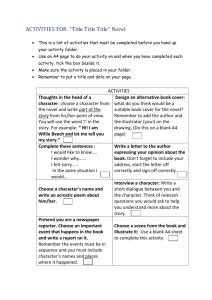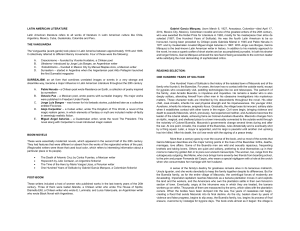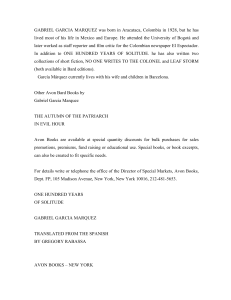Schedule of Events: Fill in the schedule you create with
advertisement
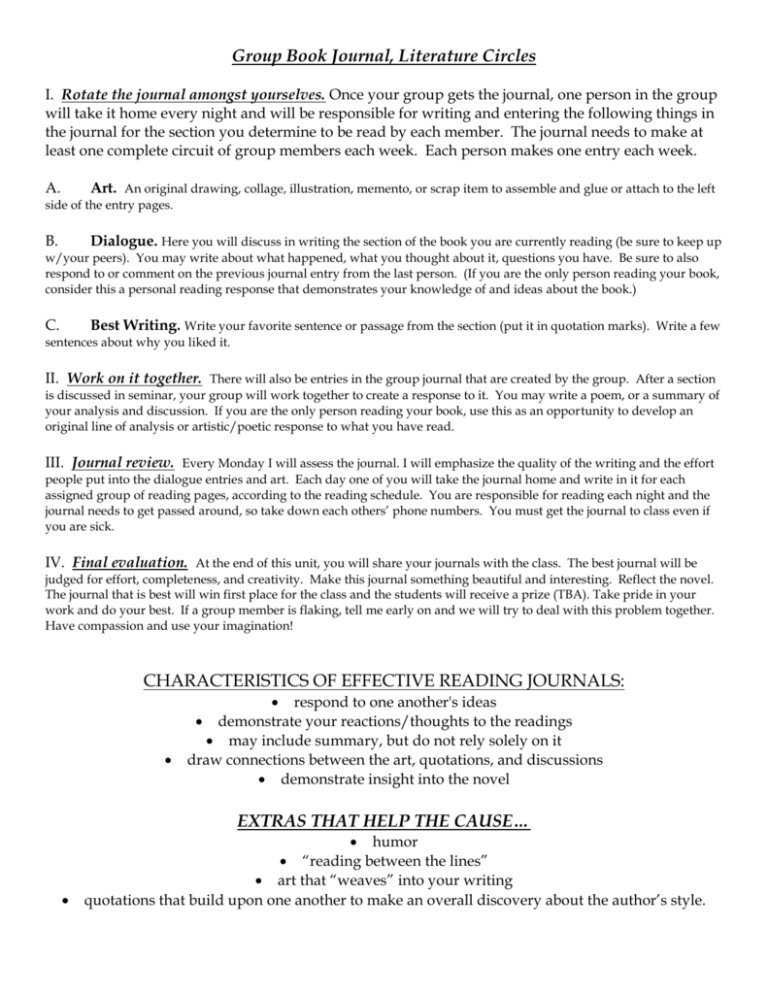
Group Book Journal, Literature Circles I. Rotate the journal amongst yourselves. Once your group gets the journal, one person in the group will take it home every night and will be responsible for writing and entering the following things in the journal for the section you determine to be read by each member. The journal needs to make at least one complete circuit of group members each week. Each person makes one entry each week. A. Art. An original drawing, collage, illustration, memento, or scrap item to assemble and glue or attach to the left side of the entry pages. B. Dialogue. Here you will discuss in writing the section of the book you are currently reading (be sure to keep up w/your peers). You may write about what happened, what you thought about it, questions you have. Be sure to also respond to or comment on the previous journal entry from the last person. (If you are the only person reading your book, consider this a personal reading response that demonstrates your knowledge of and ideas about the book.) C. Best Writing. Write your favorite sentence or passage from the section (put it in quotation marks). Write a few sentences about why you liked it. II. Work on it together. There will also be entries in the group journal that are created by the group. After a section is discussed in seminar, your group will work together to create a response to it. You may write a poem, or a summary of your analysis and discussion. If you are the only person reading your book, use this as an opportunity to develop an original line of analysis or artistic/poetic response to what you have read. III. Journal review. Every Monday I will assess the journal. I will emphasize the quality of the writing and the effort people put into the dialogue entries and art. Each day one of you will take the journal home and write in it for each assigned group of reading pages, according to the reading schedule. You are responsible for reading each night and the journal needs to get passed around, so take down each others’ phone numbers. You must get the journal to class even if you are sick. IV. Final evaluation. At the end of this unit, you will share your journals with the class. The best journal will be judged for effort, completeness, and creativity. Make this journal something beautiful and interesting. Reflect the novel. The journal that is best will win first place for the class and the students will receive a prize (TBA). Take pride in your work and do your best. If a group member is flaking, tell me early on and we will try to deal with this problem together. Have compassion and use your imagination! CHARACTERISTICS OF EFFECTIVE READING JOURNALS: respond to one another's ideas demonstrate your reactions/thoughts to the readings may include summary, but do not rely solely on it draw connections between the art, quotations, and discussions demonstrate insight into the novel EXTRAS THAT HELP THE CAUSE… humor “reading between the lines” art that “weaves” into your writing quotations that build upon one another to make an overall discovery about the author’s style. Novel Presentation/Teach-In Options You are officially going to become a teacher, sharing information and creative interpretations about your novel by “teaching” the class what you have learned. Your group should choose several of the following activities to show what you have read, learned about, and understood in a deeper sense . . . in your book. 1. Dramatize and script out a skit that captures the essence of one very vital section. You may either create a video or give a live performance. 2. Make an eye-pleasing visual poster that describes 2 to 3 themes within the section/division. Then find pictures and quotations that enhance and describe the themes. 3. Write chapter poems as a group (or each of you can take on a poem) for each chapter within your section. The poems must include one or two really important lessons or quotations from the chapter, as well as a kind of summary of what happened in that chapter. Make it poetic by using imagery, metaphor, repetition, and your own creative insights. 4. Do a historical/cultural chart of what is going on in the chapter by researching for pictures, articles, and information from the library or elsewhere. Show real events from newspapers or magazines that are related to the section of the book you are reading and give some historical anecdotes or information. 5. Create a visual project that demonstrates the connections between your book and the science fiction elements we have learned in class. Consider building a model of or a chart explaining the scientific elements of some part of your book. 6. Do a performance of a “lost scene” from the book, something that you think would enrich and help explain the book better. 7. Have a panel debate concerning issues in the novel or set up Siskel-and-Ebert-type review ”duels.” 8. Draw a cartoon version of the book by picking the best and most important scenes from the novel and writing captions for each one. 9. Develop your own idea for a project & "pitch" it to me! Schedule of Events: Fill in the schedule you create with your group: We will follow a schedule that allows you time in class to discuss the novel in “literary circles," made up of you and your group partners, reading time, and whole-class discussions of science fiction. Please remember that you will have just over two weeks to finish your novels, so use your time in class wisely and keep up with expected reading schedules during homework time. You will each be responsible for a total of three journal entries, each of which must have all of the three components listed above (dialogue/reflection, art, and best quotes). Write your nightly page requirements in the calendar below: week of: Monday Tuesday Wednesday/Thursday Block 4/13 4/20 4/27 Lit Circles Begin – create calendars Reading Workshop Seminar/ Reading Workshop Lit Circle Book check in #1 Letter #1 Reading Workshop Letter #2 Seminar/Reading Workshop Letter #3 Letter #4 Reading Workshop Seminar/Reading Workshop Letter #5 Letter Revisions & mailings Letter #6 Seminar/Reading Workshop Teach-ins Final portfolio due Lit Circle Book check in #2 5/4 Lit Circle Book check in #3 5/11 Lit Circle Book check in #4 (final) Teach-ins 5/18 Spiel Strategies 5/25 No School Memorial Day Senior Project Speech Assessment No School for Seniors Exam Review Senior Exams No School for seniors Graduation practice, time TBA Graduation at Crossroads church, 6:00 p.m. Friday Senior Retreat Reading Workshop Reading Workshop Final seminars/Teach -in planning SP Speeches Senior Exams Book Choices for the Class of 2009: A Confederacy of Dunces by John Kennedy Toole 416 pg (Won the Pulitzer Prize) John Kennedy Toole?s hero is one, ?huge, obese, fractious, fastidious, a latter-day Gargantua, a Don Quixote of the French Quarter. His story bursts with wholly original characters, denizens of New Orleans? lower depths, incredibly true-to-life dialogue, and the zaniest series of high and low comic adventures? (Henry Kisor, Chicago Sun-Times). Ignatius J. Reilly is a flatulent frustrated scholar deeply learned in Medieval philosophy and American junk food, a brainy mammoth misfit imprisoned in a trashy world of Greyhound Buses and Doris Day movies. He is in violent revolt against the entire modern age. Ignatius? peripatetic employment takes him from Levy Pants, where he leads a workers? revolt, to the French Quarter, where he waddles behind a hot dog wagon that serves as his fortress. A Confederacy of Dunces is an American comic masterpiece that outswifts Swift, whose poem gives the book its title. Set in New Orleans, the novel bursts into life on Canal Street under the clock at D. H. Holmes department store. The characters leave the city and literature forever marked by their presences — Ignatius and his mother; Mrs. Reilly?s matchmaking friend, Santa Battaglia; Miss Trixie, the octogenarian assistant accountant at Levy Pants; inept, bemused Patrolman Mancuso; Jones, the jivecat in spaceage dark glasses. Juvenal, Rabelais, Cervantes, Fielding, Swift, Dickens — their spirits are all here. Filled with unforgettable characters and unbelievable plot twists, shimmering with intelligence, and dazzling in its originality, Toole?s comic classic just keeps getting better year after year. Released by Louisiana State University Press in April 1980 and published i n paperback in 1981 by Grove Press, A Confederacy of Dunces is nothing short of a publishing phenomenon. Turned down by countless publishers and submitted by the author?s mother years after his suicide, the book won the 1981 Pulitzer Prize for Fiction. Today, there are over 1,500,000 copies in print worldwide in eighteen languages. 100 Years of Solitude by Gabriel Garcia Marquez 458 pg (Nobel Prize winning author) "Many years later, as he faced the firing squad, Colonel Aureliano Buendía was to remember that distant afternoon when his father took him to discover ice." It is typical of Gabriel García Márquez that it will be many pages before his narrative circles back to the ice, and many chapters before the hero of One Hundred Years of Solitude, Buendía, stands before the firing squad. In between, he recounts such wonders as an entire town struck with insomnia, a woman who ascends to heaven while hanging laundry, and a suicide that defies the laws of physics: The story follows 100 years in the life of Macondo, a village founded by José Arcadio Buendía and occupied by descendants all sporting variations on their progenitor's name: his sons, José Arcadio and Aureliano, and grandsons, Aureliano José, Aureliano Segundo, and José Arcadio Segundo. Then there are the women--the two Úrsulas, a handful of Remedios, Fernanda, and Pilar--who struggle to remain grounded even as their menfolk build castles in the air. If it is possible for a novel to be highly comic and deeply tragic at the same time, then One Hundred Years of Solitude does the trick. Civil war rages throughout, hearts break, dreams shatter, and lives are lost, yet the effect is literary pentimento, with sorrow's outlines bleeding through the vibrant colors of García Márquez's magical realism. Consider, for example, the ghost of Prudencio Aguilar, whom José Arcadio Buendía has killed in a fight. So lonely is the man's shade that it haunts Buendía's house, searching anxiously for water with which to clean its wound. Buendía's wife, Úrsula, is so moved that "the next time she saw the dead man uncovering the pots on the stove she understood what he was looking for, and from then on she placed water jugs all about the house." Beloved by Toni Morrison 521 pg (Nobel Prize winning author) Staring unflinchingly into the abyss of slavery, this spellbinding novel transforms history into a story as powerful as Exodus and as intimate as a lullaby. Sethe, its protagonist, was born a slave and escaped to Ohio, but eighteen years later she is still not free. She has too many memories of Sweet Home, the beautiful farm where so many hideous things happened. And Sethe's new home is haunted by the ghost of her baby, who died nameless and whose tombstone is engraved with a single word: Beloved. Filled with bitter poetry and suspense as taut as a rope, Beloved is a towering achievement. The Unbearable Lightness of Being by Milan Kundera 320 pg (Nobel Prize winning author) Tereza and Tomas, Tomas and Sabina, Sabina and Franz, Franz and Marie-Claude--four people, four relationships. Milan Kundera's masterful novel, The Unbearable Lightness of Being (1984), tells the interlocking stories of these four relationships, with a primary focus on Tomas, a man torn between his love for Tereza, his wife, and his incorrigible "erotic adventures," particularly his long-time affair with the internationally noted painter, Sabina. The world of Kundera's novel is one in which lives are shaped by irrevocable choices and fortuitous events. It is a world in which, because everything occurs only once and then disappears into the past, existence seems to lose its substance and weight. Coping with both the consequences of their own actions and desires and the intruding demands of society and the state, Kundera's characters struggle to construct lives of individual value and lasting meaning. A novel of ideas, a provocative look at the ways in which history impinges on individual lives, and a meditation on personal identity, The Unbearable Lightness of Being examines the imperfect possibilities of adult love and the ways in which free choice and necessity shape our lives. "What then shall we choose?" Kundera asks at the beginning of his novel. "Weight or lightness?" This international bestseller is his attempt to answer that question. And the answer is hinted at in the novel's final scene, in which Tomas and Tereza find themselves in a small country hotel after a rare evening of dancing. When Tomas turns on the light in their room, "a large nocturnal butterfly" rises from the bedside lamp and circles the room in which they are alone with their happiness and their sadness. Flight by Sherman Alexie 181 pg & The Catcher in the Rye by J.D. Salinger 224 pg (Unprized but notoriously talented authors) The best-selling author of multiple award-winning books returns with his first novel in ten years, a powerful, fast and timely story of a troubled foster teenager — a boy who is not a “legal” Indian because he was never claimed by his father — who learns the true meaning of terror. About to commit a devastating act, the young man finds himself shot back through time on a shocking sojourn through moments of violence in American history. He resurfaces in the form of an FBI agent during the civil rights era, inhabits the body of an Indian child during the battle at Little Big Horn, and then rides with an Indian tracker in the 19th Century before materializing as an airline pilot jetting through the skies today. When finally, blessedly, our young warrior comes to rest again in his own contemporary body, he is mightily transformed by all he’s seen. This is Sherman Alexie at his most brilliant — making us laugh while breaking our hearts. Simultaneously wrenching and deeply humorous, wholly contemporary yet steeped in American history, Flight is irrepressible, fearless, and again, groundbreaking Alexie. A classic of American coming-of-age fiction, establishes the genre of the cynical boy reaching adulthood. Flight could not have been written without it. The God of Small Things by Arhundati Roi 336 pg (Won the Booker Prize) With sensuous prose, a dreamlike style infused with breathtakingly beautiful images and keen insight into human nature, Roy's debut novel charts fresh territory in the genre of magical, prismatic literature. Set in Kerala, India, during the late 1960s when Communism rattled the age-old caste system, the story begins with the funeral of young Sophie Mol, the cousin of the novel's protagonists, Rahel and her fraternal twin brother, Estha. In a circuitous and suspenseful narrative, Roy reveals the family tensions that led to the twins' behavior on the fateful night that Sophie drowned. Beneath the drama of a family tragedy lies a background of local politics, social taboos and the tide of history?all of which come together in a slip of fate, after which a family is irreparably shattered. Roy captures the children's candid observations but clouded understanding of adults' complex emotional lives. Rahel notices that "at times like these, only the Small Things are ever said. The Big Things lurk unsaid inside." Plangent with a sad wisdom, the children's view is never oversimplified, and the adult characters reveal their frailties?and in one case, a repulsively evil power?in subtle and complex ways. While Roy's powers of description are formidable, she sometimes succumbs to overwriting, forcing every minute detail to symbolize something bigger, and the pace of the story slows. But these lapses are few, and her powers coalesce magnificently in the book's second half. Roy's clarity of vision is remarkable, her voice original, her story beautifully constructed and masterfully told. First serial to Granta; foreign rights sold in France, Spain, Portugal, Germany, Italy, Finland, Norway, Sweden, Denmark, Estonia, Holland, India, Greece, Canada and the U.K. Copyright 1998 Reed Business Information, Inc. --This text refers to an out of print or unavailable edition of this title. Temple of My Familiar by Alice Walker 416 pg (Pulitzer-prize winning author) Nothing in Walker's extraordinary new novel is fixed. Time and place range from precolonial Africa to post-slavery North Carolina to modern-day San Francisco; and the characters themselves change and evolve as their stories are told, their myriad histories revealed. Most often present are Miss Lissie, an old woman with a fascinating host of former lives; her companion, the gentle Mr. Hal; Arveyda, a soul-searching musician; his wife Carlotta, who was born in the South American jungle; Fanny, a young woman who has a tendency to fall in love with spirits; and her husband Suwelo, who tries hard but simply does not understand her. Out of the telling of their stories emerges a glorious and iridescent fabric, a strand connecting all their lives and former lives and seeming to pull all of existence into its folds. Walker's characters are magnetic, even with their all-tohuman flaws and stumblings; they seem to contain the world, and to do it justice. Highly recommended. - Jessica Grim,





